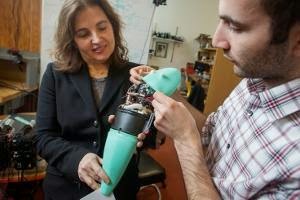Andrew Marchese, doctoral candidate in EECS at MIT (right), and Dr Daniela Rus, professor in EECS and director of CSAIL, hold the robotic fish developed by the Distributed Robotics Laboratory.
WASHINGTON: Massachusetts Institute of Technology (MIT) scientists have developed an autonomous robotic fish that can execute escape manoeuvres, convulsing its body to change direction in just a fraction of a second, or almost as quickly as a real fish can.
The self-contained robot developed by MIT is capable of rapid body motion.
The continuous curvature of the fish's body when it flexes is what allows it to change direction so quickly.
"A rigid-body robot could not do continuous bending," said Daniela Rus, a professor of computer science and engineering, director of MIT's Computer Science and Artificial Intelligence Laboratory, and one of the researchers who designed and built the fish.
The robotic fish was built by Andrew Marchese, a graduate student in MIT's Department of Electrical Engineering and Computer Science and lead author on the new paper, where he was joined by Rus and Cagdas D Onal.
Each side of the fish's tail is bored through with a long, tightly undulating channel, researchers explained.
Carbon dioxide released from a canister in the fish's abdomen causes the channel to inflate, bending the tail in the opposite direction, they said.
Each half of the fish tail has just two control parameters: the diameter of the nozzle that releases gas into the channel and the amount of time it's left open.
In experiments, Marchese found that the angle at which the fish changes direction - which can be as extreme as 100 degrees - is almost entirely determined by the duration of inflation, while its speed is almost entirely determined by the nozzle diameter.
That "decoupling" of the two parameters, he said, is something that biologists had observed in real fish.
"To be honest, that's not something I designed for. I designed for it to look like a fish, but we got the same inherent parameter decoupling that real fish have," Marchese said.
Marchese used a 3-D printer to build the mould in which he cast the fish's tail and head from silicone rubber and the polymer ring that protects the electronics in the fish's guts.
The fish can perform 20 or 30 escape manoeuvres, depending on their velocity and angle, before it exhausts its carbon dioxide canister.
But the comparatively simple manoeuvre of swimming back and forth across a tank drains the canister quickly.
"The fish was designed to explore performance capabilities, not long-term operation," Marchese said.
A new version of the fish that should be able to swim continuously for around 30 minutes will use pumped water instead of carbon dioxide to inflate the channels, but otherwise, it will use the same body design, Marchese said.
Rus said that such a robot could infiltrate schools of real fish to gather detailed information about their behaviour in the natural habitat.
We are in Facebook :
Page :-- https://www.facebook.com/i.tech.94
